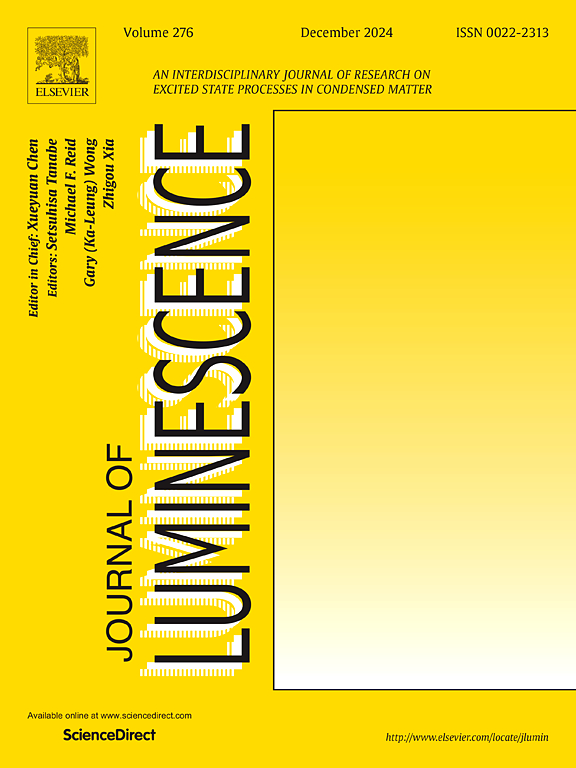Structure and optical property modulation of K+ and Rb+ doped MAPbBr3 single crystals for potential saturable absorber applications
IF 3.6
3区 物理与天体物理
Q2 OPTICS
引用次数: 0
Abstract
Organic-inorganic hybrid perovskite single crystals have emerged as promising candidates for nonlinear optical applications due to their exceptional optoelectronic properties. In this study, through doping MAPbBr3 single crystals with alkali metals K+ and Rb+, the crystal cell structure was adjusted. The defect densities of MA0.95K0.05PbBr3 and MA0.97Rb0.03PbBr3 single crystals were reduced to cm−3 and cm−3 respectively, almost half that of MAPbBr3 single crystals, which suppresses carrier recombination caused by defects. Using transient absorption spectroscopy to track carrier dynamics in the samples, it was revealed that doping with alkali metals K+ and Rb+ effectively reduces the interaction between the central cation and the Pb-Br framework, greatly slowing hot carrier relaxation, increasing carrier mobility, and reducing defect density. The nonlinear absorption coefficients of MA0.95K0.05PbBr3 and MA0.97Rb0.03PbBr3 single crystals were measured to increase to cm/MW and cm/MW respectively, an order of magnitude greater than MAPbBr3 single crystals. Our research opens a new development path for potential saturable absorbers in ultrashort pulse lasers.
K+和Rb+掺杂MAPbBr3单晶在潜在饱和吸收剂中的结构和光学性质调制
由于其优异的光电性能,有机-无机杂化钙钛矿单晶已成为非线性光学应用的有希望的候选者。本研究通过在MAPbBr3单晶中掺杂碱金属K+和Rb+,调整了晶体胞体结构。MA0.95K0.05PbBr3和MA0.97Rb0.03PbBr3单晶的缺陷密度分别降至8.05×109 cm−3和5.85×109 cm−3,几乎是MAPbBr3单晶的一半,这抑制了缺陷引起的载子复合。利用瞬态吸收光谱跟踪样品中的载流子动力学,发现碱金属K+和Rb+的掺杂有效地降低了中心阳离子与Pb-Br骨架之间的相互作用,大大减缓了热载流子弛豫,提高了载流子迁移率,降低了缺陷密度。MA0.95K0.05PbBr3单晶和MA0.97Rb0.03PbBr3单晶的非线性吸收系数分别增加到1.94×10−2 cm/MW和7.27×10−2 cm/MW,比MAPbBr3单晶高一个数量级。我们的研究为超短脉冲激光中潜在饱和吸收剂的发展开辟了一条新的道路。
本文章由计算机程序翻译,如有差异,请以英文原文为准。
求助全文
约1分钟内获得全文
求助全文
来源期刊

Journal of Luminescence
物理-光学
CiteScore
6.70
自引率
13.90%
发文量
850
审稿时长
3.8 months
期刊介绍:
The purpose of the Journal of Luminescence is to provide a means of communication between scientists in different disciplines who share a common interest in the electronic excited states of molecular, ionic and covalent systems, whether crystalline, amorphous, or liquid.
We invite original papers and reviews on such subjects as: exciton and polariton dynamics, dynamics of localized excited states, energy and charge transport in ordered and disordered systems, radiative and non-radiative recombination, relaxation processes, vibronic interactions in electronic excited states, photochemistry in condensed systems, excited state resonance, double resonance, spin dynamics, selective excitation spectroscopy, hole burning, coherent processes in excited states, (e.g. coherent optical transients, photon echoes, transient gratings), multiphoton processes, optical bistability, photochromism, and new techniques for the study of excited states. This list is not intended to be exhaustive. Papers in the traditional areas of optical spectroscopy (absorption, MCD, luminescence, Raman scattering) are welcome. Papers on applications (phosphors, scintillators, electro- and cathodo-luminescence, radiography, bioimaging, solar energy, energy conversion, etc.) are also welcome if they present results of scientific, rather than only technological interest. However, papers containing purely theoretical results, not related to phenomena in the excited states, as well as papers using luminescence spectroscopy to perform routine analytical chemistry or biochemistry procedures, are outside the scope of the journal. Some exceptions will be possible at the discretion of the editors.
 求助内容:
求助内容: 应助结果提醒方式:
应助结果提醒方式:


